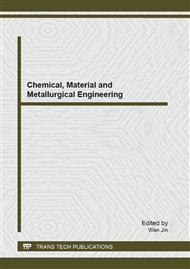[1]
T.V. Mihailovic, M.D. Nikolic and LJ. M Simonovic. Resistance to creasing of clothing wool fabrice. International Journal of clothing. Science and Technododgy. Vol. 7 No. 4 (1995), pp.9-16.
DOI: 10.1108/09556229510094823
Google Scholar
[2]
F. Shi, Y. Wang. Modeling the Creasing Properties of Woven Fabrics. The Journal of The Textile Institute, Vol. 100, No. 3 (2009). pp.218-222.
Google Scholar
[3]
H. SOMMER, F. WINKLER. Die Prűfung der Textilien. Handbook of Materials. Vol. V: The Testing of Textiles. Berlin: Springer-Verlag, (1960).
Google Scholar
[4]
M.D. Nikolic, LJ.M. Sukovic and T.V. Mihailovic. Multiaxial determination of the resistence to creasint of clothing wool fabrice,. International Journal of clothing. Science and Technododgy. Vol. 11 No. 5 (1999). pp.77-286.
DOI: 10.1108/09556229910297545
Google Scholar
[5]
K.E. Perepelkin, S.A. Neklyudova and N.A. Smirnova. Anisotropy of wrinkling of polyester, polyester-linen, and linen fabric. Fibre Chemistry, Vol. 32, No. 6 (2000). pp.444-446.
DOI: 10.1007/bf02359079
Google Scholar
[6]
L. Fridrichová, K. Zelová. Objective evaluation of multidirectional fabric creasing. The Journal of the Textile Institute, Vol. 8 (2011). pp.719-725.
DOI: 10.1080/00405000.2010.515727
Google Scholar
[7]
A. Merati, H. Patir. Anisotropy in wrinkle properties of woven fabric. The Journal of the Textile Institute, Vol. 102, No 8 (2011). p.719 – 725.
DOI: 10.1080/00405000.2010.507951
Google Scholar
[8]
B.M. Chapman, J.W.S. Hearle. The bending and creasing of multi-component viscoelastic fibre assemblies. Part I: General consideration of the problem. Journal of Textile Institute, Vol. 63 (1972a). p.385–403.
DOI: 10.1080/00405007208630241
Google Scholar
[9]
W.J. Hamburger, M.M. Platt and H.M. Morgan. Mechanics of elastic performance of textile materials. Part X: Some aspects of elastic behaviour at low strains. Textile Research Journal, Vol. 22 (1952). p.695–729.
DOI: 10.1177/004051755202201101
Google Scholar
[10]
J.F. Krasny, G.D. Mallory, J.K. Phillips, and A.M. Sookne. Crease recovery of fabrics. Part II: Effect of construction on crease recovery of fortisan fabrics. Textile Research Journal, Vol. 25 (1955). p.499–506.
DOI: 10.1177/004051755502500602
Google Scholar
[11]
Jr., F.S. Looney, C.T. Handy. The effect of construction on the wear wrinkling of dacron/wool suitings. Textile Research Journal, Vol. 38 (1968). p.989–998.
DOI: 10.1177/004051756803801003
Google Scholar


